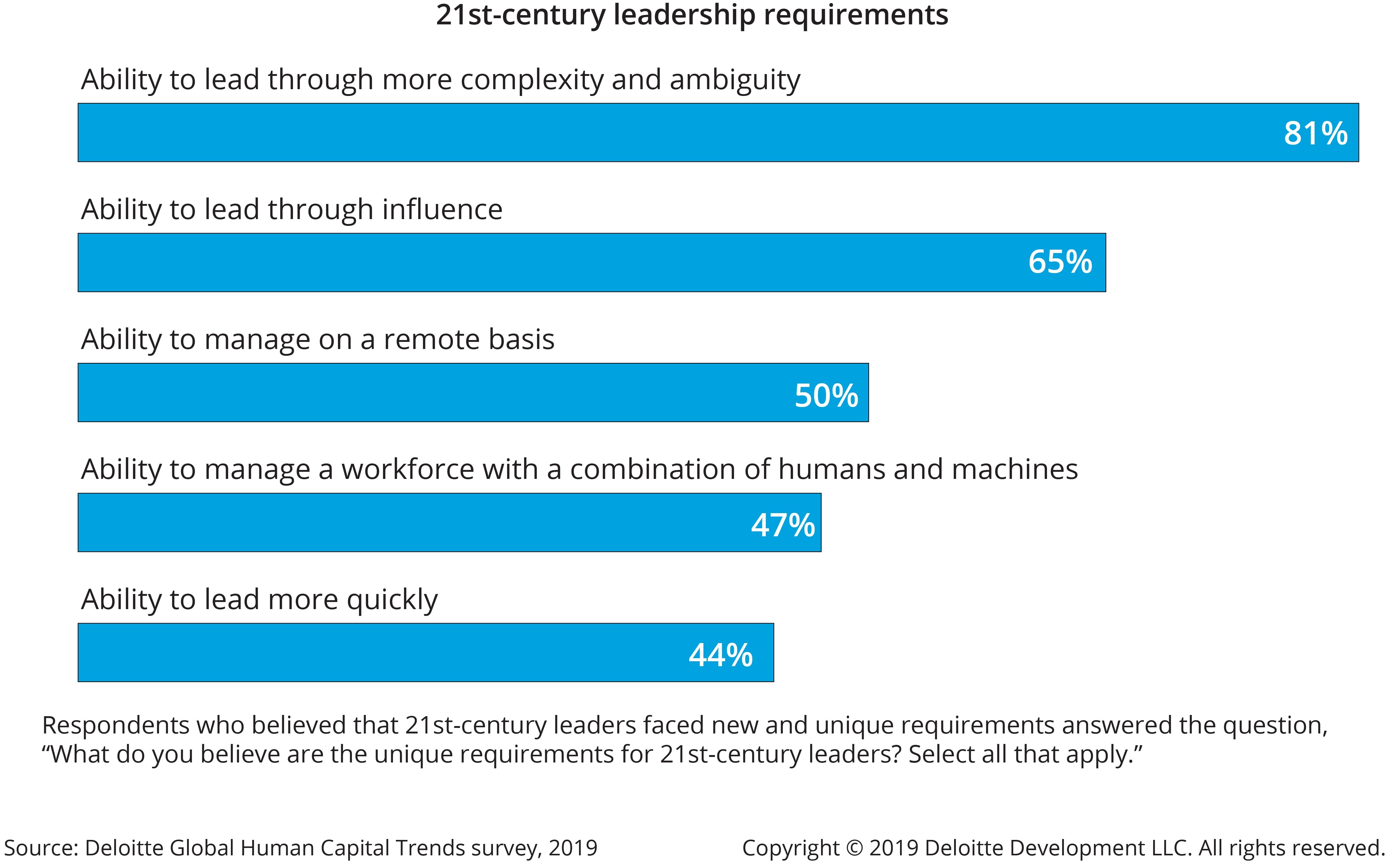Leading in a VUCA world has been saved

Perspectives
Leading in a VUCA world
How 21st-century leaders can find success amid volatility, uncertainty, complexity, and ambiguity (VUCA)
The technologies that are amplifying change are also the tools to manage it more effectively.

In Deloitte’s “2019 Global Human Capital Trends” survey, 80 percent of respondents agreed that the 21st century has imposed new requirements on business leaders.1 Among these respondents, 81 percent cited the ability to lead through more complexity and ambiguity, followed by leading through influence, managing remotely, managing a workforce that combines humans and machines, and leading more quickly.
Each of these requirements reflects elements of our connected and digital lives. Together, they point to a “VUCA” world that directly challenges the way leaders develop stability and direction for their businesses.
VUCA stands for volatility, uncertainty, complexity, and ambiguity.2 Volatility is the dynamic rate of change; uncertainty is a lack of predictability and information; complexity describes interdependent systems that do not exhibit clear cause and effect; and ambiguity acknowledges the difficulty of accurately assessing reality in a complex and volatile landscape. VUCA is dynamic and situational—sometimes things can be fairly clear but then suddenly shift due to outliers, adjacencies, and disruptions. Arguably, leaders today face an extended period of rising VUCA.
The elements of VUCA are not new but the modern world has amplified them. Amid globalization, instantaneous communications, and innovation ecosystems, leaders are more challenged by continuous change. Twentieth-century tools for a structured and predictable world are becoming less capable. Command-and-control management styles appear rigid, unresponsive, and fragile.3
In the Deloitte “2019 Global Human Capital Trends” survey, respondents have tapped into the ways that technology has changed the map. Leading through influence is more powerful in a world of hypermedia. Savvy leaders can make impacts by effectively communicating values and vision, both internally and externally. Leaders should also consider how to influence points of potential and design for emergent outcomes.4
Remote management responds to globalized skills, markets, and ecosystems. An effective business finds talent and opportunity anywhere it can, often where it costs the least. Leaders should be comfortable directing across such networks and securing trust without physical proximity.5 Distributed businesses respond to softer hierarchies and empowerment of teams to act effectively on their own.
This extends to non-humans. A complementary workforce of humans and machines can automate, innovate, and predict at greater scale and complexity. While automation can free leaders from overseeing routine tasks, machine intelligence can help them reckon with complexity.6 Business leaders should continuously develop their own technology savviness to make stronger decisions about costly transformation. Conversely, providers of such services should earn that trust.
Continuous change often requires fast decisions. Establishing clear lines of approval and setting thresholds for when a decision needs to be escalated can shorten the time to action. Companies that are extremely responsive to sudden brand assaults on social media often gain greater brand loyalty.7 This is where technologies can sense change and inform responsiveness. For example, customer relationship management solutions can use artificial intelligence to predict customer churn before it happens.
When change is the only constant, leaders should develop the ability to quickly understand and adapt. Businesses can expand their sensing capabilities—from data analytics and machine learning, to leveraging sales teams and technical support at the edges of the business. Agile feature implementations can also act as market probes to sense how well they meet customer needs.8
Twenty-first-century leadership may demand greater risk tolerance. A VUCA world almost demands failures, but these can be narrow, measured, and, most important, used to get better information and reduce uncertainty and ambiguity. Leaders may be well-served by anticipating change around every corner, modeling scenarios, and developing agile and adaptive responsiveness, both in their thinking and across their business.
This charticle authored by Chris Arkenberg on October 23, 2019.
Endnotes
1 “Leadership for the 21st century: The intersection of the traditional and the new–2019 Global Human Capital Trends,” Deloitte Insights, April 11, 2019.
2 “Q. Who first originated the term VUCA (Volatility, Uncertainty, Complexity, and Ambiguity?”, US Army Heritage & Education Center, May 7, 2019.
3 Liz Ryan, “Command-and-Control Management Is for Dinosaurs,” Forbes, February 26, 2016.
4 Cade Metz, “Salesforce Boss Benioff Beats Larry Ellison at Own Game,” Wired, October 5, 2011.
5 Billy Bosworth, “5 Practical Ways to Engage a Geographically Distributed Workforce,” Harvard Business Review, June 5, 2018.
6 Julian Vigo, “Why Machine Learning Is the Future of Business Culture,” Forbes, June 6, 2019.
7 “Responsiveness on Social Media Drives Millennials’ Loyalty,” Marketing Charts, January 1, 2019.
8 “Leadership Skills for an Uncertain World,” Center for Creative Leadership.
Recommendations
Gen Z and millennial travel: The wanderlust generations
Millennials’ love for travel fuels new business opportunities


